Should have to must 차이 – Navigating the subtle distinctions between “should,” “have to,” and “must” is essential for effective communication. These terms, often used interchangeably, convey varying degrees of obligation, subjectivity, and certainty, and understanding their nuances is crucial for precise language usage.
Delving into the depths of these modal verbs, we will explore their differences in usage, obligation, subjectivity, modality, and grammatical considerations, equipping you with the knowledge to employ them with confidence and clarity.
Difference in Usage
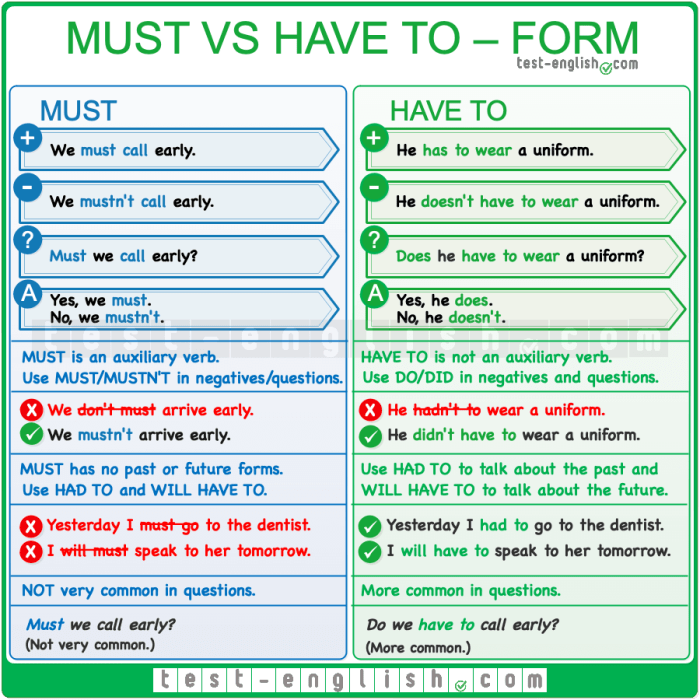
In English grammar, “should,” “have to,” and “must” are modal verbs that express obligation or necessity. While they share some similarities, they have distinct nuances in their usage and the level of obligation they convey.
“Should”
“Should” is used to express advice, recommendations, or expectations. It suggests that something is advisable or appropriate, but not necessarily obligatory. For example:
- You should get enough sleep before a big test.
- You should try this new restaurant; it’s supposed to be amazing.
“Have to”
“Have to” expresses a stronger obligation or necessity. It indicates that something is required or unavoidable. For example:
- I have to finish this project by tomorrow.
- You have to obey the law.
“Must”
“Must” conveys the strongest obligation or necessity. It is used when something is absolutely essential or imperative. For example:
- You must attend the meeting.
- You must not cheat on your taxes.
Degrees of Obligation
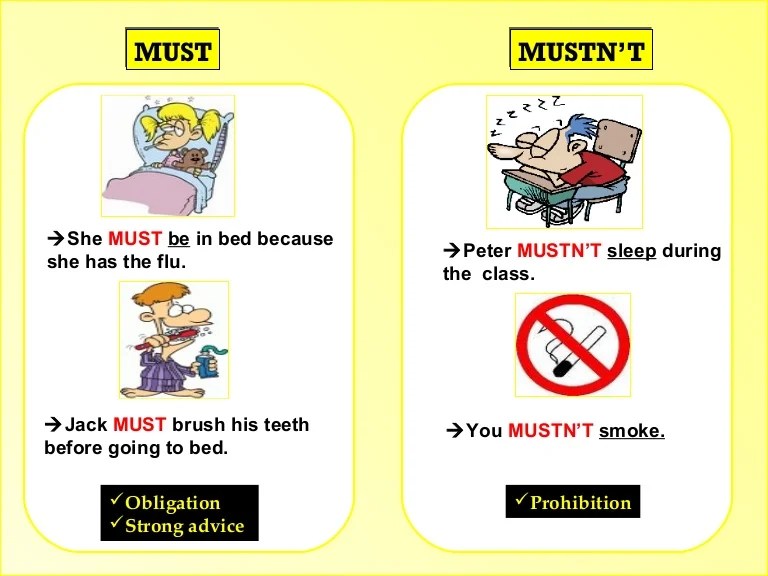
“Should,” “have to,” and “must” convey varying degrees of obligation. “Should” expresses advice, recommendation, or expectation, indicating something that is desirable or advisable to do. “Have to” conveys a stronger sense of necessity or obligation, often due to external circumstances or requirements.
“Must” is the strongest term, indicating an absolute necessity or requirement, often involving a sense of duty or compulsion.
Grasping the nuances of “should,” “have to,” and “must” is crucial for precise communication. If you’re curious about this topic, delve into the raisin in the sun quiz . It’s a great way to test your understanding while exploring the depths of this grammatical topic.
Should
“Should” suggests an obligation based on social norms, personal values, or expectations. It implies that something is advisable or recommended but not strictly required. For example:
- You should brush your teeth twice a day.
- You should be respectful of others.
- You should consider all the options before making a decision.
Have to
“Have to” indicates a stronger sense of obligation, often due to external circumstances or requirements. It suggests that something is necessary or unavoidable. For example:
- I have to go to work today.
- I have to finish this project by Friday.
- You have to obey the law.
Must
“Must” is the strongest term, conveying an absolute necessity or requirement. It often implies a sense of duty or compulsion. For example:
- You must return the borrowed book.
- You must be honest in your dealings.
- You must follow the company’s safety regulations.
Subjective vs. Objective
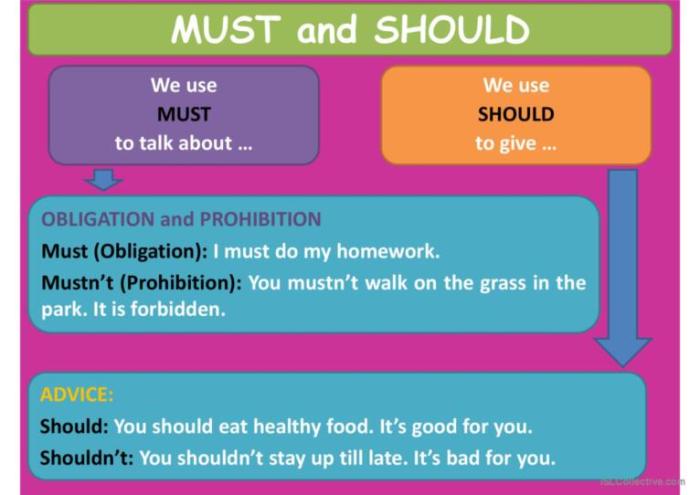
The terms “should,” “have to,” and “must” differ in their subjective and objective nature. This distinction significantly influences how these terms are interpreted and applied.
Subjectivity of “Should”
“Should” expresses a subjective opinion or recommendation. It implies an obligation based on personal beliefs, values, or expectations. The interpretation of “should” can vary widely depending on the individual’s perspective and context.
Objectivity of “Have to” and “Must”
“Have to” and “must” convey objective obligations or necessities. They indicate an external requirement or constraint that is independent of personal opinions or preferences. These terms are often used in situations where there is a clear authority or rule that must be followed.
4. Modality and Certainty
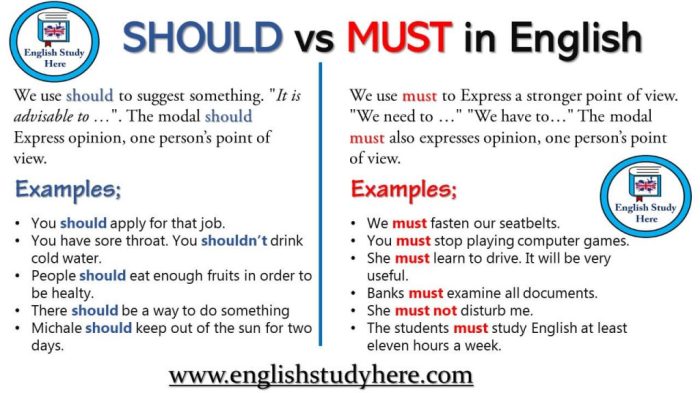
Modal Properties of “Should,” “Have to,” and “Must”
The modal verbs “should,” “have to,” and “must” express varying degrees of obligation or necessity. They also convey different levels of certainty or possibility.
“Should” expresses advice, recommendation, or expectation. It indicates that something is advisable or expected but not necessarily obligatory. “Have to” expresses a stronger obligation or necessity. It indicates that something is required or necessary to do. “Must” expresses the strongest obligation or necessity.
It indicates that something is absolutely necessary or required.
Degrees of Certainty or Possibility
In addition to expressing obligation, these modal verbs also convey different degrees of certainty or possibility.
The distinction between “should have,” “to have,” and “must” is a nuanced one. For a deeper understanding, check out on page 2 of passage 2 , where the differences are explained in more detail. By delving into this resource, you’ll gain a better grasp of the subtle variations between these modal verbs.
“Should” expresses a moderate degree of certainty or possibility. It indicates that something is likely or probable but not certain. “Have to” expresses a higher degree of certainty or possibility. It indicates that something is very likely or almost certain.
“Must” expresses the highest degree of certainty or possibility. It indicates that something is absolutely certain or inevitable.
The subtle nuances between “should,” “have to,” and “must” often cause confusion. In a similar vein, the recent revelation of obey me cheating on mc has sparked discussions about the boundaries of loyalty and forgiveness. Understanding these linguistic differences can enhance our communication and comprehension of such complex issues.
5. Examples and Counter-Examples
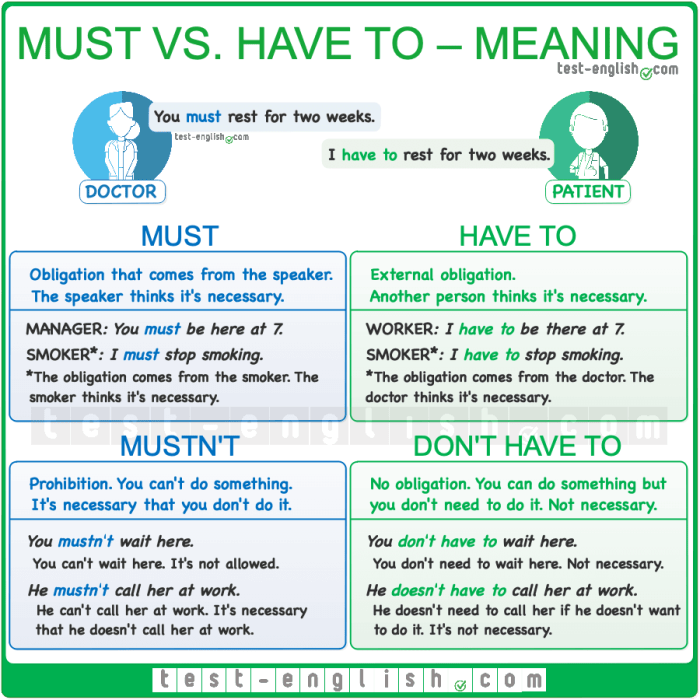
To illustrate the nuanced differences between “should,” “have to,” and “must,” let’s examine specific examples and counter-examples:
Example 1
- Should:You should wash your hands before eating.
- Explanation:“Should” expresses a recommendation or advice based on social conventions or personal judgment.
Counter-Example 1
- Have to:I have to go to the doctor today.
- Explanation:“Have to” implies an obligation or necessity that cannot be avoided.
Example 2
- Must:You must follow the instructions carefully.
- Explanation:“Must” conveys a strong sense of obligation or requirement, often imposed by authority or necessity.
Counter-Example 2
- Should:You should try the new restaurant in town.
- Explanation:“Should” suggests a recommendation or suggestion, not a strict obligation.
Grammatical Considerations
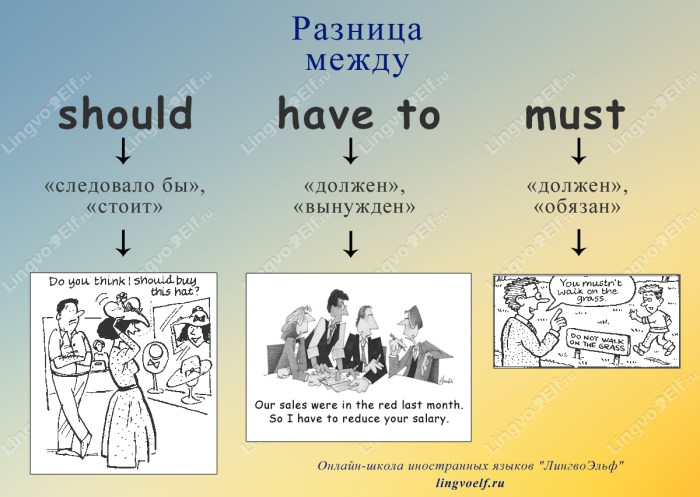
The grammatical constructions associated with “should,” “have to,” and “must” vary depending on their specific usage and the context in which they appear.
Modal Verbs
All three words are modal verbs, which are a type of auxiliary verb used to express possibility, necessity, advice, or permission. Modal verbs are always followed by another verb, typically in the infinitive form.
Infinitive Forms, Should have to must 차이
When used to express obligation or necessity, “should,” “have to,” and “must” are typically followed by the infinitive form of the main verb. For example:
- You should studyfor your exam.
- You have to goto the store.
- You must finishyour homework.
Other Grammatical Features
In addition to modal verbs and infinitive forms, “should,” “have to,” and “must” can also be used with other grammatical features, such as:
- Perfect infinitive: to express an obligation that has already been fulfilled. For example: You should have studiedfor your exam.
- Progressive infinitive: to express an ongoing obligation. For example: You should be studyingfor your exam.
- Passive infinitive: to express an obligation that is performed by someone or something else. For example: The report must be completedby Friday.
Essential FAQs: Should Have To Must 차이
What is the primary difference between “should” and “must”?
“Should” expresses advice or obligation based on personal opinion or social norms, while “must” conveys a strong obligation or necessity.
When is it appropriate to use “have to”?
“Have to” indicates an external obligation or compulsion, often imposed by authority or circumstances.